|
|
Ranger In Charge 1985-1993,
Senior Ranger 1993 to present.
Interviewer: Vanessa Ryan
So Brett, what's your relationship with Girraween?
My relationship with the park was that I was a Div One Overseer in Charge for a number of years and then became Ranger in Charge for the park. In total I worked here, actually on the park, for eight years. 1985 through to whatever eight years after that is...
|
|
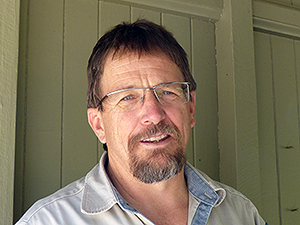
Brett Roberts.
|
|
'93?
'93... Something like that. And since that time, to the present day, I've been the Senior Ranger. So I've had a supervisory role over the park since then ... basically I've still had an input into the management of the park.
So you are based in Toowoomba?
I'm based in Toowoomba. Yes. So it's just one of a number of management units that I've had under me.
You've just answered my first three or four questions...
Very good.
Ok... Ah, had you ever been to Girraween before you started working here?
Yes, I had. I came in 1979 as a college student - the first of the Wilderness Reserve course at Gatton. We came down here for a week to ten days. And it was in November. It was Summer and we camped in Bald Rock Creek camping area, up just above the present toilets down there. We froze at night and we boiled during the day. [Laughs.] At the end of the ten days I go "I don't think I'll work here". [Laughs.] And then I end up spending most of my working life associated with it. So yeah.
So it was just one of those things meant to be...
There were two places in Queensland... Because I was a coastal boy I wanted to go to Fraser and work where it was warmer. The next coldest place in Queensland was Bunyas and I got to work there as well! [Laughs.]
I take it that you don't like the cold?
Uh, you get used to it. But yeah, I wasn't a cold weather person.
So when you were saying you were at Gatton... You were studying... You knew you wanted to be in Parks?
Yes. It the first course in Queensland designed for people to work in National Parks.
And how long was that for?
That was two years. It was an Associate Diploma, as they called it back in those days. And yeah, it was a two year course and you had to do about twelve weeks practical work out in different parks.
So it was mostly theory?
Yeah.
What sort of things did you cover?
How to plant sorghum, at one point... [Laughs.]
[Laughing.] So useful stuff.
Useful stuff at times. Well, because the course was the first year [it had been run], we were blended into some of the Agricultural courses. Which, in hindsight, some of it was ok. Especially the cattle side of things because being a city kid I didn't know much about cattle. It gave an insight a bit into that side of things. For when you are dealing with neighbours that have got cattle. So yeah... There was some basic motor mechanic type stuff and really basic fire management and park management and theories about interpretation.
So it gave you a good standing for when you started the job?
Yes. For that period of time, yeah.
So how did you come about working in Girraween?
Well, I was working at Bunya's at the time and I ended up being transfered down to here. The ranger house was only about eighteen months old and so my wife and I shifted down here and, yeah, we started our family down here as well.
So I suppose we'll talk about your family now? What did your partner do while you were working out in the [park]?
She looked after me really good for a bit... [Laughs.] No... She did a little bit of casual work and then also did Grace Cosmetics. She built up a business doing Grace Cosmetics. We even did stands at the show and things like that as well.
So she kept her mind active.
Yes. She was very busy selling the cosmetics.
Did she do anything around the park to help you out? Like run tours?
Oh yeah. She would come out and help out a little bit and look after sick and injured wildlife from time to time that we brought in. We looked after possums and wallabies and a few things like that over the period of time. She would come and just be supportive when we did slide shows in Gunn's Cottage here and that sort of thing, so. It was good.
Were your kids born while you were here?
Two of our three were born in Stanthorpe and when the youngest one was about eighteen months old and the other was just about to start school at about four...five...that's when we shifted through to Toowoomba.
So they didn't need to go to school in this area?
No, they didn't.
So your wife, may I ask her name?
Sharon.
Sharon was looking after the kids at home?
Yeah, looking after the kids at home. Taking them for bushwalks, all that sort of stuff.
Oh, what a childhood!
Yes. It was a great life and while they probably don't really remember a lot of those days because they were so young, they certainly had a lot of fun climbing rocks and playing down the creek catching tadpoles and all those sorts of things.
Do you think that early experience has effected them as they've grown up? Like, do they have an interest in the natural environment now?
A little bit. Not greatly, but they do have a little bit of an interest. They still go camping and visit National Parks. Yeah.
Let's get back to working... Your side of things... Who were the staff that you worked with?
When I first turned up, there was Lawrie Shelly... He was the Overseer in Charge at the time. Bill Goebel was still working for a few months before he retired, so I worked with him for about probably four or five months. Um, Bill's brother Hock... I [also] worked with him until he retired. And a lady called Colleen Gravatt who was our Interp. and plant guru for the park at the time. They were the original ones and then over a period of time, obviously Bill left and Ian Elms started working here. And his brother Glen, Stubbie. And you, know, there's a host of other people who roll on...
Short term workers?
Yeah, a few short term workers. And then, I suppose, since I've been Senior Ranger for the area, I've also been responsible for recruiting all the RICs to the position since then. So people like John Cowburn, John Moye, Peter Lindsay, Jamie Seeleither. I think they're the main ones who have been RIC in that period of time. And also a number of the other staff who've turned up here, I've also been responsible for part of the recruitment for those people.
I have to ask, what sort of people do you look for? You know, is it personality, is it knowlege base, experience... A mixture?
Yeah, well it's a mixture of all those. Basically you want someone that wants to care for the environment, but sometimes you want people that come with certain skills. So you mix and match your skills. You know, someone that's got good small motor maintenence or maybe operation of plant equipment or chainsaw operators or backhoe and tractor drivers and that sort of thing. So you try to mix and match your skills across your work force so that there's someone there to train other people in those jobs. People that know plants, know fire... So there's a whole range. So for instance, with Jo and her predecessors, it was about being a people's person. Being able to communicate well, make displays, do guided walks and all those sorts of things.
So, is there a sort of a skill set... A certain park would have a skill set that would be different to another park's?
I think generally they are pretty similar. Like Noosa probably doesn't need a heavy plant equipment person, whereas here, because our people get used out further west on other reserves, they may need [that skill]. [At Noosa] they are probably more people based and maybe a bit more walking track maintenence based - using smaller machinery like little backhoes and excavators to do work or, you know, that sort of thing. So, generally, the skill sets are the same, but they're just skewed to one area or another.
Uh huh. So we get on to the next question. What sort of duties did you undertake while you were in Girraween?
Oh look... Everything and anything. I suppose in those days we did a lot with the camp grounds. So from mowing, cleaning the toilets, doing the basic maintenence - you know little basic plumbing jobs... And even building some of the picnic tables. Painting picnic tables. Those sort of jobs. Erecting signs.
During my time when I was RIC here, we started getting the fire break system more up to scratch. So slashing those and actually putting in a couple of extra ones - like the one that runs from the top of the Underground Creek through to Mt Norman. Basically doing fire management - fighting wild fires, doing planned burns.
|
|
[We] started spraying the blackberries in the valley here as the first effort in trying to get rid of blackberries off the park. And other weeds like Coriopsis... You know, when we first started at the end of the picnic area there, there was just solid masses of yellow flowers that you see in other parts of the distric now.
You guys have done an excellent job. You see it all the way in and then it just stops.
Yeah. So they've probably been some of the successes. Then basically just running the work program as a Ranger in Charge. Like making sure that we've got people to clean toilets and, you know, public and school holidays and all those sorts of things. Patroling and doing talks and walks and all those sorts of things that are part of process back then.
So what would have been your biggest achievement? The one that you are most proud of while you were here?
|
|
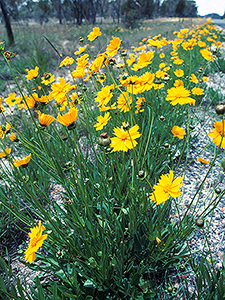
Coreopsis lanceolata, an introduced weed.
|
|
Oh look, I think that the biggest achievement is some of the staff that we've put on here. Because if you make that decision right, that makes your job a lot easier. And so having people like Jo and John Cowburn and those sort of people that are very capable, you can give them a guide "this is where we are going" and they can just go off and do it. And you come in, you have a look at what they are doing and monitor it from a distance, but you're not managing the project so much. You've got capable people. So for me, having really good Rangers on the ground - and that goes for Ian at Sundown who was [also] here - really good operators on the ground and you know that things are going to get done and they're keen. I suppose over the last ten years, we came up with a redevelopment plan for Girraween.
Yes, I've seen that.
Having that plan in place and then trying to impliment it as much as we could. You know, it's not finished, but I don't think it will ever be finished because circumstances change over that length of time. I think, you know, the picnic area now is a lot better than what it ever was and a lot safer for people. Families can go picnic without worries of cars zooming around anywhere in the picnic area. It looks quite attractive down there with the barbecues and the shelter sheds. So I think the updating of the visting infrastructure here and being a part of that process...
Probably getting the blackberries off the park has been a good one too. It's something that's not seen, it's not obvious to people because once the weed is gone they don't notice it. But it has a flow on effect in that it takes away a lot of haven for rabbits... Not to say there's no rabbits, but it basically reduces the areas that rabbits could dig into for burrows. So from that point of view, there are some good outcomes, yeah.
|
|
While you were here, did you experience any major fires, floods or other natural disasters?
Well, I've seen every major wild fire since I've been here. There was one in the late '80s, 1994, 2002 and 2012. They're probably the bigger fires - especially 2002 which was like nearly a twenty day campaign fire. By time it burned through Horans Gorge we stopped it and it got going again. And then it came back again. Yeah, it was a long, hard process. And so probably the fires have been the biggest natural disasters.
There's been some floods but, you know, but flooding here is up and down and it's done and a day later you can drive anywhere you want to go - except out the back of the park. But any of the bitumen roads and all that get opened up again, so flooding is not a big issue here. Basically there's been the odd search and rescue, helping people who have come to grief. Yeah, generally fires have been the biggest issue.
|
|
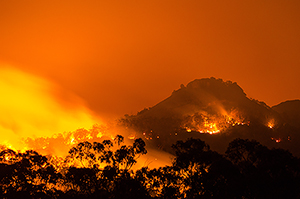
Fire at the base of the Pyramids, 2014.
|
|
Did it ever snow while you were here?
Not to any great extent. I have seen snowflakes, but nothing every really piled up on the ground. In 1984, July '84 when there was the big snowfall here, I was at the Bunyas and saw snow up there on the ground. Friends came up with kids, we built some snowmen up there and then when it did snow down here last Winter I wasn't available to come down, so I missed out on it.
Like Jo...
Like Jo. So yeah. I have been out in the bush and seen the snowflakes, but as soon as they get about waist high they just disappear.
|
|
Drats.
Yeah, drats! Cold and ugly, but not cold enough.
Enough to make it horrible to work in...
Yeah.
We'll get back to your family and your living here... So you actually did live here in the park?
Yeah, we lived on the park in the Ranger's House.
And that was still fairly new?
Yes. It would have been only built in 1983 or thereabouts.
So good accomodation for you?
Good accomodation. Yep.
|
|
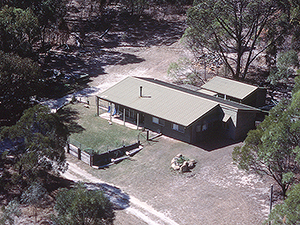
Girraween's accomodation
for its Ranger in Charge.
|
|
What would be your fondest memory from your time working here?
Oh, my fondest memory... There's lots of them. I suppose it's those little moments where something will happen and it's very situational. So it's very hard to sort of repeat and to get the full picture. Just those moments when... just a little bit of pranking around happens and someone tries to do something else and they come to grief trying to do it.
I remember one day, someone found a little rabbit and we put it in Hock's car. [Laughs.] We all just waited and all we could hear was car doors opening and banging and him trying to catch this rabbit inside his car. [Laughs.] So there was times like that and yeah...
From the family point of view, it was just having the kids and going for a bushwalk with them and enjoying the bush with them. And bringing them back, as well. Like, living in Toowoomba and coming back for little holidays at times.
Umm... Other fondest times... Yeah, look, just walking around and enjoying the place. Seeing different orchids and wildflowers and the obligatory beautiful sunset at times. So yeah. There's a whole range of things like that.
|
|
You mentioned the orchids and flowers. Do you have a specific interest in flowers or animals?
I always called myself more of a generalist. Back in those days, I took a lot of slides and I threw a lot of slides away as well... Because, you know, they weren't good enough. But basically I would take a lot of slides and use those slides for telling people about the park - doing slide shows in Gunn's Cottage here. And so, yeah, it was a way of getting to know the park. Just exploring it and trying to get photos of granite rocks and all that sort of thing.
So if experts - like botanists from the Herbarium came out - would you go out in the field with them?
|
|
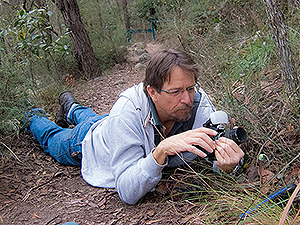
Brett still enjoys photography.
|
|
Yeah. One of the things we did when I was here was set up the first fire monitoring plots. Unfortunately, the data out of that hasn't worked. We did bring out Bill McDonald and Colleen Gravatt was very good on the plants... And so we brought those people out and we set up a number of sites around the park just to get a better handle of what sort of effect fire had on the vegetation. So, yeah, we'd go around with some of the experts.
Would the experts come here a lot?
Oh, you'd get them every now and again, yeah. Girraween at times would get a run of people then you'd go twelve months or eighteen months and not hear from anybody. It just depends what projects they had on and whether if fitted in to what we wanted on the park.
You know, Girraween is the place of flowers... So I was just wondering if the botanists were keen to come up here when they could?
Oh look, yeah. If you talk to a lot of the botanists in the Herbarium, [for] a lot them this is a very favourite place. Like Michael Maitheson, Bill McDonald, Carol Sandercoe? You know, the list goes on and they've all had, at some point, time that they've spent here and even in their own private time coming up... Yeah.
So if they find something new and exciting, do they let you guys know?
Yeah, basically they do. I mean, Girraween's pretty well been walked all over and mapped. We've had people like Kym Sparshott, who used to work for the department, do a detailed vegetation map of the park and she walked everywhere and took a number of what she thought might be new species, but most of them had been [already] recorded at some stage. So yeah, the plant count is fairly high. I can't remember off the top of my head how many plants... Seven hundred or something?
Oh, it's over a thousand...
Over a thousand. So from that point of view, at times its had a lot of work done in it over the years.
Do you have any interesting stories or other anecdotes you'd like to tell?
Oh... Any interesting other stories? Yeah, I just can't think of any off the top of my head. Sorry.
That's all right. Well, you were saying you looked after sick and injured animals.
Yes.
How did they come about? Just people find them and bring them to you?
People that we knew in town would say, hey... You know. And we would look after them for a while and rehabilitate them and let them go.
So did your course at Gatton help you, prepare you, for that sort of thing?
No, not really. [Laughs.] No.
Were there people you could call on?
Oh, local vets. If something was really injured, you'd get a local vet to have a look at it. It was probably in the days before dedicated wildlife carer groups... We had wildlife rangers at that stage in the department. On their advice and vet advice we'd look after them.
Still on the topic of animals, did you see Girraween's two main animals much - the lyrebird and the wombat - while you were here?
Probably heard the lyrebirds more than we saw them. And the wombat, um, I used to come across their droppings every now and again, but I never got to see a live one. Mind you, I didn't go chasing them really heavily, given that they are a nocturnal animal... Yeah, I did see - walking through the hills and that - we'd actually come across droppings. If they were fresh, you'd say, oh that's good. It's a good indicator that they are still around. And yeah, just bushwalking or working in the bush and hearing the lyrebirds calling and that sort thing, yeah.
I think our best experience - you've said yours - was one day, I'm not sure what time of year it was, but we were sitting on Castle Rock. There was a brisk, cool wind blowing but the rock was warm from the sun and we could hear a lyrebird singing in the valley below us. It was just so beautiful, so peaceful.
It is. Yeah. That happens quite a bit. Like when we put that track in, along east of Mt Norman there. There's lyrebirds in that gully there. So when we weren't running tractors and doing work, sitting down for lunch, you could hear them calling and that sort of thing. See them occasionally up there when we've gone along that track.
|
|
So you did the Mt Norman track?
Yes.
Both the north side and the south side?
Well, that's what we call the Mt Norman fire track - which is the vehicle track that runs from the Day Use Area to the top of the Underground Creek...
That's now the shared bike trail?
Yes, that's the bike trail. There was a little bit of a really old farm track partly up that which we stuck to as best we could, then we lost sight of it and just picked the best way through. In 1979 when we came and did work experience here, I was actually working on the walking track that went from Castle Rock to Mt Norman. So, we did a few days out there doing track work.
|
|
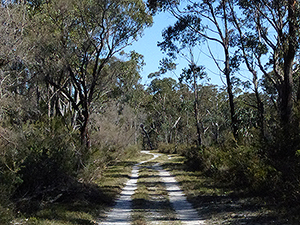
The peaceful Peak Trail, once the Mt Norman fire track.
|
|
All by hand?
All by hand. All by pick and shovel and rakehoe and wheelbarrows and buckets and that sort of thing. So yeah. I was a lot fitter back then. [Laughs.]
[Laughs.] I was just going to say... That was a full day? You didn't just sort of do a few hours..?
No, it was full days. It was November and like I said, it was freezing cold - it may have been quite dry at that time. So really cold nights. I had two jumpers on and still felt cold at night time. And then you turn up for work at 7 o'clock and you start walking... You know... ten minutes you take one jumper off and twenty minutes later you take the next one off and then you're carrying them and by the time you're out there, you're sort of stripped down to a singlet sort of thing, to stay cool. So there was quite a variation in temperature at that time of year.
And then the wind would get up and you'd freeze again...
Yeah! During the day, you know, it's a bit like today, quite pleasant. But you can imagine if you're swinging on a hoe or a mattock at that in the sun, it's quite hot. You'd be warm all day.
Yeah, other fond memories... Sometimes just being out in the bush on some of those fires... You know. And just seeing reflections in water, that sort of thing. And in the last fire, in 2014, I actually took a really nice shot from the Barracks, looking back over here from when the fire was still burning along the ridge here.
What was your reason for leaving Girraween? Well, you never have really left it, have you?
Yes, I never really have left it, as such, but I suppose some of it was family reasons. We thought it would be good to be in town for schooling. There was a promotional opportunity to go to Toowoomba. It was supposed to be just for twelve months and I've been there for over twenty years now. Yeah, basically once we got there, we enjoyed it and the kids got into good schools. The kids are just about all gone now... It's just a matter of the last one is going to Gatton now doing wildlife management, so once he finishes that course, well, there'll be no reason we can't move on.
So, would you think you'd come back to this area?
I gave it very serious consideration before Greg got appointed to actually come back to the park. It was very close, but I felt it would probably never be the same as what it was. I mean, it's still good, but it just wouldn't be quite the same. And I went up there for a change as well, just changing work to see how that would go. See what happens in the future.
Whatever opportunities you're given or offered?
Yeah, that's right. Or whatever you can grab.
So when you were here as Ranger in Charge, has much changed since then?
I think we've got a big shed built... The new workshops down there. So we basically moved out of the double garage here.
So while you were here, the workshop was next to Gunn's?
Gunn's was the base and that's where everything was done from. And then, towards the end of the time I was here, we got the first of the big sheds built down behind the Barracks. Yeah, I think that was a good move just to get it down there, get the stuff away from people.
|
|
Really, the place has just made little improvements here and there. Like the picnic area and updating the toilet blocks in the camp grounds. The rest of the park...we haven't put any new walking tracks in. I mean there is the new Wyberba Walk, but it was always there as a rough little track. We've just formalised it more for people to be able to use.
Wheelchair friendly...
Yeah, disabled access friendly. But basically, all the walking tracks have stayed the same, because that's what we can manage effectively.
So, in your position higher up in the echelon, do you know of any future plans for Girraween? Like more tracks, or..?
|
|
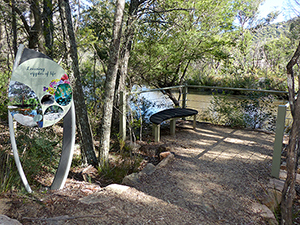
View point, Wybera Walk.
|
|
At this stage, I'd say it'll be of more status quo than anything else in the foreseeable future. There are no big, major capital works projects on the cards because we've got the new day use area and the camp grounds are doing their jobs.
If there was lots of money being thrown at us from government, we might put in a camp ground designed for large school groups so they don't clash with the grey nomads. And if we had lots and lots of money I'd build a more function purpose auditorium for people to use. But, they're not just going to get off the ground at the moment.
Well, thank you very much for that. And now, may I take your photo?
[Laughs.] Now you're stretching the friendship! Yeah, that's fine.
|
|

